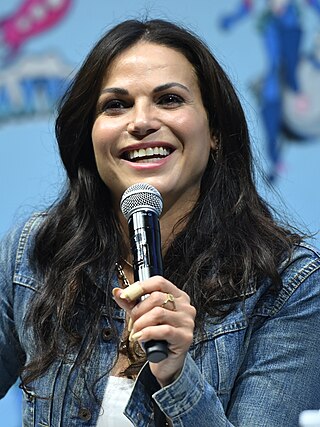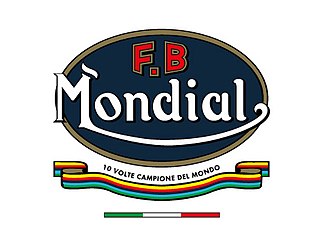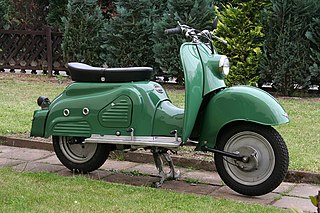
Aprilia is an Italian motorcycle manufacturer founded immediately after World War II in Noale, Italy, by Alberto Beggio. The company started as a manufacturer of bicycles and moved on to manufacture scooters and small-capacity motorcycles. Since in the 1980s, Aprilia has also produced large sportbikes such as the 1,000 cc V-twin RSV Mille and the V4 RSV4.

Lana Parrilla is an American actress. She was a regular cast member in the fifth season of the ABC sitcom Spin City (2000–2001) and in the fourth season of 24 (2005), and starred in Boomtown (2002–2003), Windfall (2006), Swingtown (2008), and as Dr. Eva Zambrano in the short-lived medical drama Miami Medical (2010), and as The Evil Queen / Regina Mills in the ABC fantasy drama series Once Upon a Time (2011–2018). Among her awards and nominations is a 2012 ALMA Award win for Outstanding TV Actress - Drama. In 2021, she played the role of Rita Castillo in the second season of Why Women Kill.

FB Mondial is a motorcycle manufacturer, founded in 1929, in Milan, Italy. They are best known for their domination of Motorcycle World Championships between 1949 and 1957. The firm produced some of the most advanced and successful Grand Prix road racers of the time, winning five rider and five manufacturer World Championships in that short period.
Derbi is a manufacturer of motorcycles, scooters, mopeds and recreational all-terrain vehicles produced by Nacional Motor S.A.U., currently integrated into the Italian (2009) Piaggio Group.

The 1951 Grand Prix motorcycle racing season was the third F.I.M. Road Racing World Championship Grand Prix season. The season consisted of eight Grand Prix races in five classes: 500cc, 350cc, 250cc, 125cc and Sidecars 500cc. It began on 8 April, with Spanish Grand Prix and ended with Nations Grand Prix on 9 September. As of 2024, this is the most recent season the premier class was won by a non-Japanese or non-Italian constructor.

The 1955 Grand Prix motorcycle racing season was the seventh F.I.M. Road Racing World Championship Grand Prix season. The season consisted of eight Grand Prix races in five classes: 500cc, 350cc, 250cc, 125cc and Sidecars 500cc. It began on 1 May, with Spanish Grand Prix and ended with Nations Grand Prix in Italy on 4 September.

The 1956 Grand Prix motorcycle racing season was the eighth F.I.M. Road Racing World Championship Grand Prix season. The season consisted of six Grand Prix races in five classes: 500cc, 350cc, 250cc, 125cc and Sidecars 500cc. It began on 8 June, with Isle of Man TT and ended with Nations Grand Prix in Italy on 9 September.

The 1959 Grand Prix motorcycle racing season was the 11th F.I.M. Road Racing World Championship Grand Prix season. The season consisted of seven Grand Prix races in five classes: 500cc, 350cc, 250cc, 125cc and Sidecars 500cc. It began on 17 May, with French Grand Prix and ended with Nations Grand Prix in Italy on 6 September.

The 1960 Grand Prix motorcycle racing season was the 12th F.I.M. Road Racing World Championship Grand Prix season. The season consisted of seven Grand Prix races in five classes: 500cc, 350cc, 250cc, 125cc and Sidecars 500cc. It began on 22 May, with French Grand Prix and ended with Nations Grand Prix in Italy on September 11.
The history of the motorcycle begins in the second half of the 19th century. Motorcycles are descended from the "safety bicycle," a bicycle with front and rear wheels of the same size and a pedal crank mechanism to drive the rear wheel. Despite some early landmarks in its development, the motorcycle lacks a rigid pedigree that can be traced back to a single idea or machine. Instead, the idea seems to have occurred to numerous engineers and inventors around Europe at around the same time.

Bianchi was a brand of Italian motorcycle made from 1897 to 1967 by F.I.V. Edoardo Bianchi S.p.A. The company also produced automobiles from 1900 to 1939, and today is a major Italian bicycle manufacturer. Edoardo Bianchi started his bicycle manufacturing business in a small shop on Milan's Via Nirone in 1885. Bianchi was a prominent name in the motorcycle racing world from 1925 to 1930.

Philip Edward Irving (1903–1992) was an Australian engineer and author, most famous for the Repco-Brabham Formula One and Vincent motorcycle engines. He also worked at Velocette motorcycles, twice and designed the engine of the 1960 EMC 125cc racer.
Joey Litjens is a motorcyclist from America, Netherlands.

Capriolo, later called Aeromere, was the name of the motorcycle production arm of the Italian aircraft company Aeromere or Aero-Caproni. After World War II, the victorious Allies prohibited wartime aircraft and other military hardware suppliers from remaining in their previous industries, and Aero-Caproni would change its name to Capriolo and become one of several, including Aermacchi, MV Agusta, Vespa and Ducati, that switched to producing motorcycles or scooters. These companies did well until the mid-1960s, when the advent of affordable cars like the Fiat 500 removed the economic barrier that kept many Italians relying on motorcycles for basic transportation. Capriolo was typical of those that could not survive the transformation to a more export-orientated industry, with the US as the most important market. Motorcycle production ran from 1947 or 1948 until 1964.
Fantic Motor is an Italian manufacturer of motorcycles.

Fabio Fabiani is an Italian auto racing driver.

The Zündapp Bella is a motor scooter manufactured by German motorcycle manufacturer Zündapp from 1953 to 1964. Approximately 130,000 Bella scooters were sold, with engine sizes ranging from 150 to 200 cc.

Malanca was an Italian motorcycle maker. The company's founder, Mario Malanca, started the venture by building mechanical parts and hubs for motorcycle wheels before producing his first complete motorcycle in 1956.

The MV Agusta 125 Bialbero was a 125 cc factory racer from the Italian brand MV Agusta, which was used between 1950 and 1960. The machine won 34 GPs, 6 rider's championships and one manufacturer's championship. The machine also won 4 Italian Championships and 10 National Championships in other countries.













